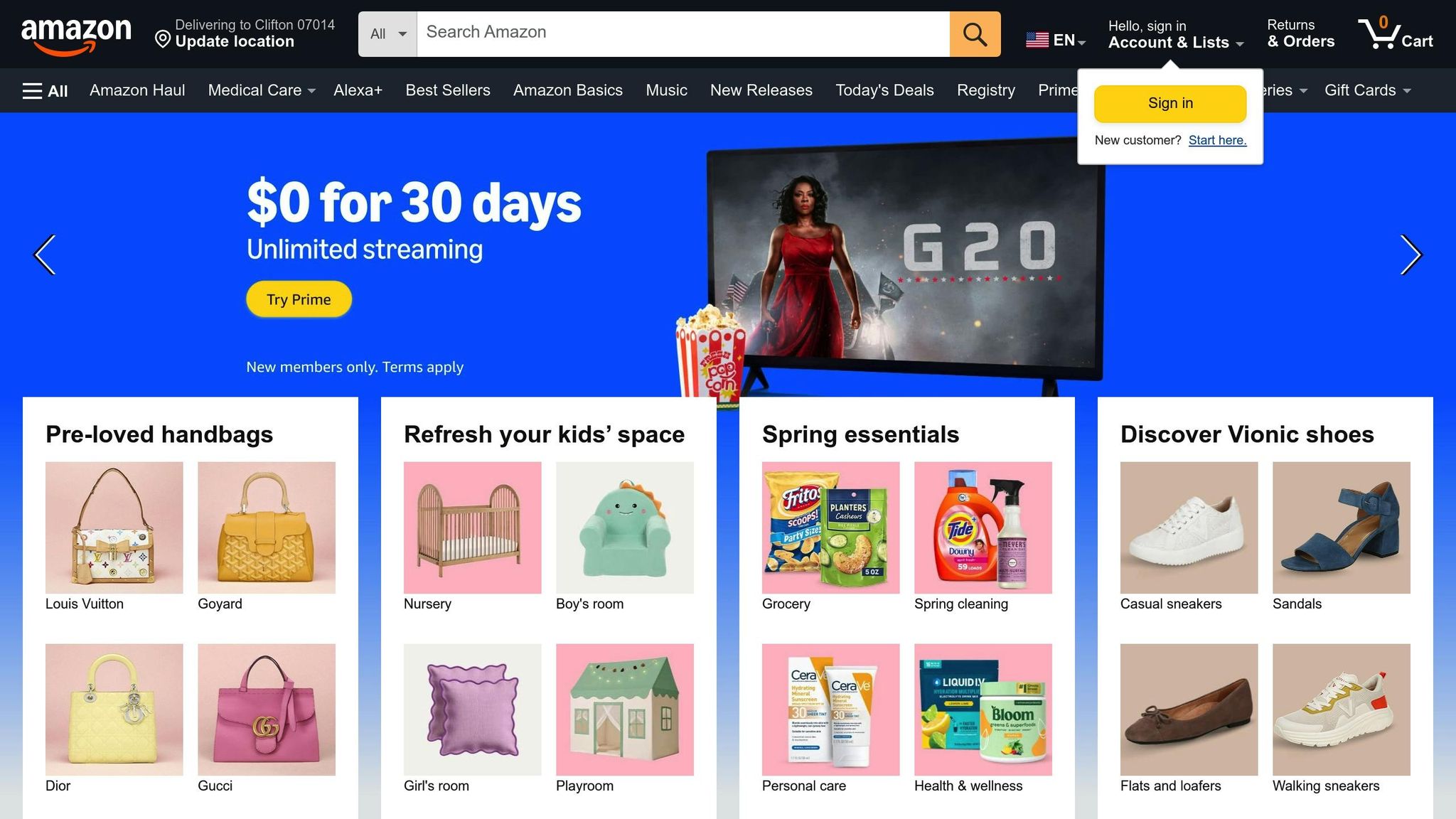No, Shopify is not owned by Amazon. Shopify is an independent, publicly traded company that helps businesses create and manage their own online stores. While Shopify and Amazon collaborate on tools like the Amazon Sales Channel and "Buy with Prime", they operate as separate entities with different business models.
Here’s a quick breakdown:
- Shopify: A SaaS platform that allows merchants to build customizable online stores with full control over branding, pricing, and customer data.
- Amazon: A retail marketplace where sellers list products and Amazon controls customer interactions and data.
Key Facts About Shopify:

- Ownership: Shopify is publicly traded on the NYSE and TSX. CEO Tobias Lütke controls 33.8% of voting power.
- Founded: Shopify began in 2006, evolving from a snowboarding equipment store.
- Market Share: Shopify powers nearly 2 million merchants globally, holding 11% of the global eCommerce platform market.
Quick Comparison:
| Feature | Shopify | Amazon |
|---|---|---|
| Business Model | SaaS eCommerce platform | Retail marketplace |
| Brand Control | Full customization | Limited framework |
| Customer Data | Merchants own data | Controlled by Amazon |
| Revenue Model | Subscription + service fees | Commission-based |
| Checkout Process | Customizable with Shop Pay | Standard checkout |
Shopify’s independence gives businesses full control over their online presence, making it a top choice for brands prioritizing autonomy and customization.
The Difference Between Amazon and Shopify for Sellers

Who Owns Shopify
Shopify is a publicly traded company listed on the NYSE and TSX, making its shares available to investors worldwide. This structure shapes how the company is governed and the decisions it makes.
Stock Market Presence
Shopify’s ownership is divided among different groups:
| Shareholder Type | Ownership Percentage |
|---|---|
| Institutional Investors | 30.44% |
| Company Insiders | 0.16% |
| Public Companies and Individual Investors | 69.39% |
Leadership Structure
At the helm of Shopify is Tobias Lütke, the company’s CEO and co-founder. Lütke plays a key role in steering Shopify’s direction and maintaining its independence. Thanks to a dual-class share structure, he controls about 33.8% of the company’s voting power.
"His creation would one day evolve into Shopify, a name that has become synonymous with online retail."
This voting power has allowed Lütke to oversee major developments, such as launching Shopify Payments and Shopify Plus, creating the Fulfillment Network, and acquiring 6 River Systems. His leadership ensures that Shopify remains focused on its core mission and strategic goals.
Amazon’s Non-Involvement
Amazon does not own any part of Shopify. While the two companies have collaborated on certain projects, their relationship is purely strategic.
"To address the elephant in the room: Amazon does not own Shopify. Despite collaborations and integrations that benefit both platforms, they remain distinct entities, each with unique business models and objectives."
These collaborations enhance functionality for users but do not compromise Shopify’s autonomy or decision-making.
Shopify’s Path as a Solo Company
Company Origins
Shopify’s story began in 2004 when Tobias Lütke and his partners started an online snowboarding equipment store called Snowdevil. Frustrated by the lack of suitable eCommerce platforms, Lütke built his own. Two years later, in 2006, this platform officially became Shopify.
By 2008, Shopify’s monthly recurring revenue had grown substantially, hinting at the rapid growth ahead. The platform’s rise was fueled by smart product development and continuous improvements.
"If you believe something needs to exist, if it’s something you want to use yourself, don’t let anyone ever stop you from doing it." – Tobias Lütke, CEO of Shopify
This early success set the stage for Shopify’s long-term strategy to remain independent.
Maintaining Independence
Shopify has stayed independent by making key moves over the years:
| Year | Key Development | Impact |
|---|---|---|
| 2009 | Shopify App Store | Allowed third-party developers to expand functionality |
| 2013 | Shopify Payments | Brought payment processing in-house |
| 2014 | Shopify Plus | Entered the enterprise commerce market |
| 2019 | Shopify Fulfillment Network | Built its own fulfillment infrastructure |
| 2021 | Shopify 2.0 | Improved customization and platform flexibility |
Instead of seeking external ownership, Shopify focused on creating a complete eCommerce platform. By 2012, the company had grown 61%, hosting over 18,000 stores that generated more than $270 million in total revenue. By 2014, Shopify supported 120,000 online retailers, bringing in $105 million.
Shopify ensured its autonomy by shifting its revenue model from taking a percentage of sales to a mix of subscription fees and transaction charges. This approach provided steady income tied to the platform’s growth.
Today, Shopify holds about 11% of the global eCommerce platform market and nearly 30% of the US market. It powers a network of nearly 2 million merchants across 175 countries, supported by over 8,000 apps and 178 themes.
sbb-itb-6768865
How Shopify and Amazon Work Differently
Core Business Differences
Shopify operates as a SaaS platform, allowing merchants to create and manage their own online stores. On the other hand, Amazon functions as a retail marketplace that connects buyers with multiple sellers. This key difference shapes how each platform supports its sellers.
How Each Serves Sellers
Shopify provides merchants with:
- Full control over brand identity and customer relationships
- Direct access to customer data
- Flexible pricing options without market-driven constraints
- No referral fees when using Shopify Payments
- Multi-channel selling options
Shopify’s checkout system has been shown to improve conversion rates by an average of 15%. Additionally, its Shop Pay service now boasts over 150 million users.
Platform Features Side-by-Side
Here’s a comparison of how Shopify and Amazon differ in their offerings:
| Feature | Shopify | Amazon |
|---|---|---|
| Business Model | SaaS eCommerce platform | Retail marketplace |
| Brand Control | Full customization | Limited framework |
| Customer Data | Complete ownership | Controlled by Amazon |
| Pricing Control | Flexible | Market dependent |
| Revenue Model | Monthly fees + service fees | Commission-based |
| Marketing Tools | Platform tools + 8,000+ apps | Internal system |
| Checkout Process | Customizable with Shop Pay | Standard checkout |
| Global Reach | Multi-language/currency | Marketplace presence |
Improving a Shopify store’s site speed by just one second can increase mobile conversion rates by up to 27%. This level of control allows merchants to shape their brand and customer experience in ways that aren’t possible on Amazon.
What This Means for CPG Marketing
Brand Control Advantages
Shopify’s independent platform gives CPG brands complete control over their digital presence. This means companies can design shopping experiences tailored to their audience without being limited by marketplace rules. Brands can directly manage pricing, product placement, and customer relationships, all on their own terms.
The platform also allows for fully customized storefronts while ensuring consistent branding across every customer interaction. This level of control lets brands fine-tune the customer journey – from the first click to the final purchase.
Shopify’s Marketing Tools
Shopify provides CPG brands with built-in marketing tools that simplify both acquiring new customers and keeping existing ones engaged. These tools work together to deliver several key benefits:
| Marketing Channel | Features | Results |
|---|---|---|
| SMS Marketing | Direct messaging to customers | 6x higher engagement compared to email |
| Email Marketing | Automated campaigns | Includes welcome sequences and cart recovery |
| Social Integration | Multi-channel presence | Gives a unified view of customers |
| Analytics | Tracks performance | Enables real-time adjustments |
"Unify your marketing. Find more customers, build profitable relationships, and make strategic decisions with unbiased data – all from one place." – Shopify Canada
With these tools and the added advantage of independence, CPG brands can refine every part of their marketing and operations.
Why Platform Independence Matters
Operating independently gives CPG brands several clear benefits:
- Improved Performance: Even a one-second improvement in site speed can boost mobile conversion rates by up to 27%.
- Direct Customer Interaction: Access to customer data allows for highly personalized marketing strategies.
- Pricing Freedom: Brands can set their own prices without being constrained by marketplace rules.
- Scalability: Easily integrate with multiple sales channels while maintaining centralized management.
This independence helps CPG brands create growth strategies that align with their goals while protecting their brand identity. Shopify’s infrastructure supports businesses of all sizes, making it a solid option for companies looking to scale.
Conclusion
Ownership Details
Shopify operates as an independent e-commerce platform, led by CEO Tobias Lütke, who holds approximately 33.8% of the voting power. By 2022, Shopify had grown to support over 2 million businesses globally, handling a gross merchandise volume of $197 billion.
Key Differences Between Platforms
Shopify’s approach to e-commerce stands in contrast to Amazon’s marketplace model. While Amazon primarily functions as a retail marketplace, Shopify provides businesses with tools to create and manage their own online stores. This distinction highlights Shopify’s focus on empowering businesses to establish their own unique digital presence.
Benefits for CPG Brands
These differences are particularly advantageous for CPG brands, offering them greater control over their branding and marketing strategies. Shopify’s independent structure allows these brands to maintain full ownership of their digital assets, protected under intellectual property laws.
| Feature | Advantage for Brands |
|---|---|
| Platform Control | Ownership of customer relationships |
| Data Access | Direct insights into customer behavior |
| Brand Customization | Fully tailored storefronts |
| Global Reach | Opportunities in 175 countries |
This setup helps CPG brands build scalable and enduring businesses while keeping control over their brand identity and customer connections. Shopify’s infrastructure and focus on merchant independence make it a key tool for achieving sustained growth in e-commerce.
These factors highlight why Shopify is a preferred platform for brands prioritizing autonomy and long-term success in the digital marketplace.
FAQs
How does Shopify’s independence from Amazon help merchants succeed?
Shopify’s independence from Amazon gives merchants full control over their online stores, allowing them to create a unique brand identity and deliver a tailored customer experience. This freedom is essential for businesses that want to stand out in a competitive market.
Merchants on Shopify also benefit from access to customizable tools for designing their stores, managing customer data, and running personalized marketing campaigns. This level of control empowers businesses to build stronger relationships with their customers and optimize their eCommerce strategies for long-term growth.
Does Shopify collaborate with Amazon, and how does it affect Shopify’s operations?
Yes, Shopify and Amazon have formed strategic collaborations that benefit Shopify merchants. One key partnership is the integration of Amazon’s Buy with Prime feature, which allows Shopify merchants to offer Amazon’s trusted shipping and fulfillment services directly to their customers. This enhances the shopping experience with faster and reliable delivery options.
Additionally, Shopify merchants can connect their stores to Amazon’s sales channel, enabling them to manage inventory and fulfill orders seamlessly through Shopify. These collaborations make it easier for Shopify users to expand their reach and streamline operations while maintaining their independence as business owners.
Who owns Shopify, and how does its leadership shape the company’s direction?
Shopify is an independent company founded by Tobias Lütke, who continues to play a key role in its leadership as CEO. The company operates independently and is not owned by Amazon or any other major corporation.
Shopify’s leadership is committed to empowering businesses of all sizes by providing tools that make it easy to create and manage online stores. This focus on democratizing e-commerce drives its strategic decisions, ensuring that entrepreneurs have the resources they need to succeed in the digital marketplace.

